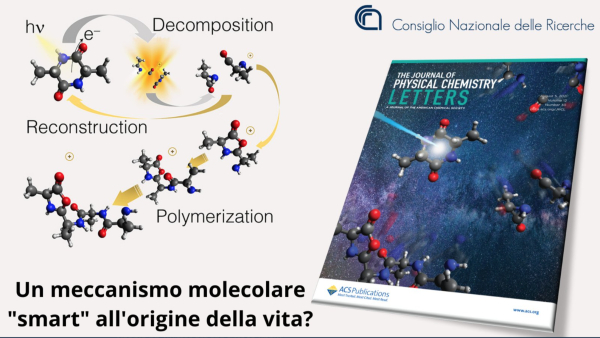The origin of life has intrigued philosophers and scientists since the dawn of human culture. How did the first organic molecules, building blocks of the complex biological systems we know today, develop? If simple prebiotic molecules formed in space and reached Earth on board of comets and meteorites, as suggested by the observations of the Rosetta mission and the analysis of the Murchinson meteorite, how did they survive cosmic rays during long interstellar journeys and harsh primordial Earth environment millions of years ago?
A collaboration that has involved ISM-CNR and Elettra synchrotron for the experimental part and the Autonomous University of Madrid and Stockholm University for the theoretical modeling studied the decomposition of the cyclic Alanine dipeptide, one of the simplest oligopeptides, exposed to VUV radiation present also in the cosmic rays, the ionizing radiation diffused in the interstellar space.
This study, cover article of the J. Phys. Chem. Lett. issue on the 5th August, proposes a model that reveals new possible survival and polymerization mechanisms of these small complexes of amino acids that, by exploiting two intramolecular peptide bonds, are characterized by a simple and robust cyclic structure.
Mass spectrometry experiments on cycle(AlanineAlanine) exposed to monochromatic VUV radiation at the Elettra synchrotron (Trieste) have shown how the ionizing radiation causes the breaking of several intramolecular bonds, resulting in the fragmentation and decomposition of the molecule. The theoretical study and the molecular dynamics simulations have allowed to propose the molecular structure and reactivity of these fragments, showing the surprising potential of cycle(Alanine Alanine) i) to 'be reborn', like a phoenix, from the recombination of its own decomposition products or ii) to produce a cyclic structure, oxazolidinone, which can become the 'seed' for the formation of longer linear peptide chains.
Monday, 04 October 2021 14:45
A “smart” molecular mechanism at the origin of life?
 "Smart Decomposition" of Cyclic Alanine-Alanine Dipeptide by VUV Radiation: A Seed for the Synthesis of Biologically Relevant Species
J. Phys. Chem. Lett. 2021, 12, 30, 7379
"Smart Decomposition" of Cyclic Alanine-Alanine Dipeptide by VUV Radiation: A Seed for the Synthesis of Biologically Relevant Species
J. Phys. Chem. Lett. 2021, 12, 30, 7379
An experimental and theoretical study, cover article of the J. Phys. Chem. Lett. which has involved researchers from the Institute of Structure of Matter, proposes a model in which simple combinations of amino acids not only survive the interaction with VUV radiation, but exploit it to generate more complex peptide chains.
These mechanisms, which theoretical simulations have shown to be energetically favoured, may have played a role in the early stages of the chemical evolution of life.
#dipeptides #synchrotron #radiation #moleculardynamics
Published in
Publications

 English (UK)
English (UK)  Italiano (Italia)
Italiano (Italia)